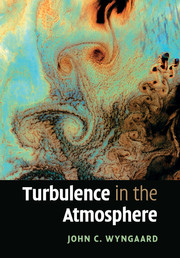Book contents
- Frontmatter
- Contents
- Preface
- Part I A grammar of turbulence
- Part II Turbulence in the atmospheric boundary layer
- 8 The equations of atmospheric turbulence
- 9 The atmospheric boundary layer
- 10 The atmospheric surface layer
- 11 The convective boundary layer
- 12 The stable boundary layer
- Part III Statistical representation of turbulence
- Index
9 - The atmospheric boundary layer
from Part II - Turbulence in the atmospheric boundary layer
Published online by Cambridge University Press: 11 April 2011
- Frontmatter
- Contents
- Preface
- Part I A grammar of turbulence
- Part II Turbulence in the atmospheric boundary layer
- 8 The equations of atmospheric turbulence
- 9 The atmospheric boundary layer
- 10 The atmospheric surface layer
- 11 The convective boundary layer
- 12 The stable boundary layer
- Part III Statistical representation of turbulence
- Index
Summary
Overview
A body in a moving fluid has a boundary layer on its surface (Figure 9.1). Near the leading edge this boundary layer is laminar; it becomes turbulent at a downstream distance xtran where the local Reynolds number U∞xtran/v exceeds about 5 × 105. This turbulent boundary layer can be seen with flow-visualization techniques (Van Dyke, 1982).
In the early 1970s the acoustic sounding technique pioneered by McAllister et al. (1969) and Little (1969) made the atmospheric boundary layer (ABL) visible as well (Figure 9.2). Its instantaneous top (Figure 2.2) can be even thinner than we can easily measure. Neff et al. (2008) discuss the use of the acoustic sounder in the quasi-steady stable ABL at the South Pole.
The ABL has several important features:
It is a region of continuous turbulence, instantaneously bounded by a thin, sharp top, the convoluted, ever-changing interface between the turbulent motion and the stably stratified, nonturbulent flow above. As a free-stream boundary (Figure 2.1) of a turbulent flow, its local, instantaneous thickness could be of the order of the Kolmogorov microscale η (Corrsin and Kistler, 1955; Corrsin, 1972).
Averaging produces a much thicker interfacial layer at the ABL top; in it the mean potential temperature increases smoothly with height, the mean-wind components transition to their free-stream values, and the turbulence level decreases to near zero. Its thickness can be as much as 20–50% of the mean depth of the boundary layer. […]
- Type
- Chapter
- Information
- Turbulence in the Atmosphere , pp. 193 - 214Publisher: Cambridge University PressPrint publication year: 2010
- 2
- Cited by

